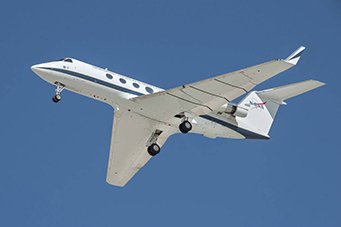WASHINGTON - A series of NASA flight tests has successfully demonstrated technologies that achieve a significant reduction in the noise generated by aircraft and heard by communities near airports.
| |

The ARM flights were flown on NASA’s SubsoniC Research Aircraft Testbed G-III aircraft, or SCRAT, at NASA’s Armstrong Flight Research Center in California. NASA combined three technologies, including Landing Gear Noise Reduction, landing gear cavity treatments, and the Adaptive Compliant Trailing Edge flexible wing flap, to demonstrate a reduction in airframe noise in excess of 70 percent. This may reduce aircraft noise for communities that live near airports.
Credits: NASA/Ken Ulbrich
|
The Acoustic Research Measurement (ARM) flights tested technology to address airframe noise, or noise that is produced by non-propulsive parts of the aircraft, during landing. The flights successfully combined several technologies to achieve a greater than 70 percent reduction in airframe noise.
While porous concepts for landing gear fairings have been studied before, NASA’s design was based on extensive computer simulations to produce the maximum amount of noise reduction without the penalty of increasing aerodynamic drag. The landing gear cavity was treated with a series of chevrons near its leading edge, and a net stretched across the opening to alter airflow, aligning it more with the wing.
“The number one public complaint the Federal Aviation Administration receives is about aircraft noise,” said Mehdi Khorrami, an aerospace scientist at NASA’s Langley Research Center in Virginia, and principal investigator for Acoustic Research Measurement. “NASA’s goal here was to reduce aircraft noise substantially in order to improve the quality of life for communities near airports. We are very confident that with the tested technologies we can substantially reduce total aircraft noise, and that could really make a lot of flights much quieter.”
Another area of focus was landing gear cavities, also a known cause of airframe noise. These are the regions where the landing gear deploys from the main body of an aircraft, typically leaving a large cavity where airflow can get pulled in, creating noise. NASA applied two concepts to these sections, including a series of chevrons placed near the front of the cavity with a sound-absorbing foam at the trailing wall, as well as a net that stretched across the opening of the main landing gear cavity. This altered the airflow and reduced the noise resulting from the interactions between the air, the cavity walls, and its edges.
To reduce wing flap noise, NASA used an experimental, flexible flap that had previously been flown as part of the ACTE project, which investigated the potential for flexible, seamless flaps to increase aerodynamic efficiency. As opposed to conventional wing flaps that typically feature gaps between the flap and the main body of the wing, the ACTE flap, built by FlexSys Inc. of Ann Arbor, Michigan, is a seamless design that eliminates those gaps.
Significant reduction in aircraft noise must be realized in order for air transportation growth to maintain its current trend. The reduction of airframe noise using NASA technology is an important achievement in this effort, as it may lead to quieter aircraft, which will benefit communities near airports and foster expanded airport operations.
“This airframe noise reduction produced by NASA technology is definitely momentous, and the best part is that it directly benefits the public,” said ARM Project Manager Kevin Weinert. “While there are obvious potential economic gains for the industry, this benefits the people who live near major airports, and have to deal with the noise of aircraft coming in to land. This could greatly reduce the noise impact on these communities.”
For more information about NASA’s aeronautics research, you may visit www.nasa.gov/aeroresearch.

